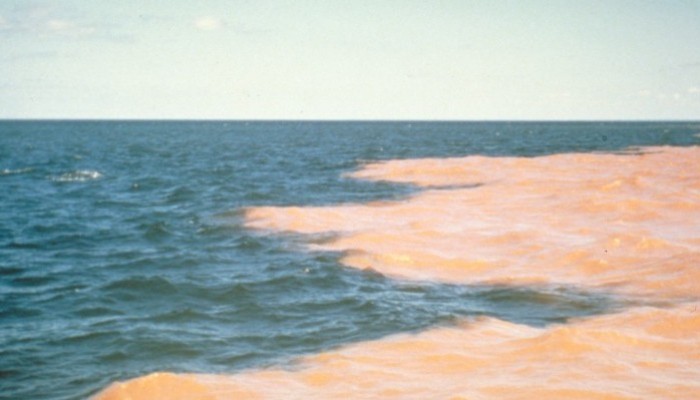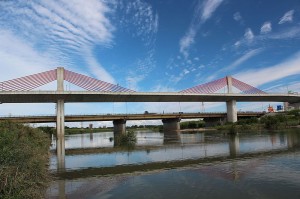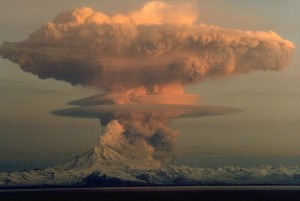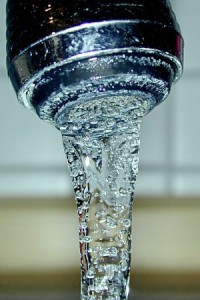Hi! And welcome to Geology Jenga and our very first blog post :)!
As this is our first post, we have picked a topic that integrates elements of both our research interests. In this initial post, we aim to give a flavour of the science that will be covered on our blog in the future, provide an introduction to the techniques we employ in our PhD’s and hopefully provide some useful insight into how scientists interested in reconstructing past environments operate.
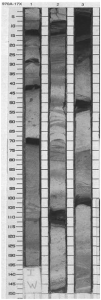
Photographed sections of core 17X, Site 970. Taken from the ODP Proceedings Volume 160. The dark bands are the organic-rich sapropels within a carbonate-rich sediment matrix
The Integrated Oceanic Drilling Programme (IOPD) has extracted numerous long sediment cores from marine basins all over the globe. Striking changes in the colour, texture or chemical composition of material in these sediment cores often tells a story of major environmental change. As a case study, we will investigate some stratigraphic records from the Mediterranean Sea. These cores contain sediments accumulated over the past several hundred thousand years (spanning much of the Quaternary) and provide a near-continuous record of environmental changes in the region.
Of particular interest to oceanographers are a series of dark, black bands rich in organic matter identified in sediment cores from the Mediterranean Sea, and at nearby terrestrial sites, termed ‘sapropels’. They are instantly recognisable as they are found within a sediment matrix rich in carbonate and much lighter in colour, sometimes grey or white (as seen in these photographic logs of core 17X, Site 970). Their re-occurrence suggests a repeated, dramatic shift in local environmental conditions. Numerous important papers have been published on these in recent decades, such as Rossignol-Strick et al. (1982) in Nature.
It appears that periods of stratification of the water column in the Mediterranean trigger the formation of sapropels (Rossignol-Strick et al. 1982), as highly saline water at the bottom of the Mediterranean are depleted in oxygen, thereby preserving the organic matter as it settles out at the sea floor. Identifying the mechanism which would cause the cyclical nature of sapropel formation has been challenging and a follow-up blog article will examine various proposed hypotheses in more detail. These include pulses of Eurasian ice-sheet meltwater, increased rainfall around the Mediterranean or flood-rich phases of the Nile River.
Here, we will focus on laboratory techniques scientists employ to distinguish these sapropelic layers in a sediment core. Colour is not always an effective proxy as it can be altered significantly since the time of deposition. In the case of sapropels, the organic matter may oxidise through time, leaving no visual imprint in the extracted sequence – ‘ghost sapropels’.
Geochemical measurements can help with this problem. Concentrations of the element Barium (Ba) can be used as a tracer as they appear to respond to biological productivity. Measurements across sapropel layers show enriched Ba (Moller et al. 2012), indicating elevated productivity during these time periods. Titanium (Ti) is a minerogenic element often used as a proxy of intense weathering and transport of silt and fine-sand particles and concentrations of Ti appear to decrease across the sapropelic layers, suggesting reduced sediment flux from land to the marine basin. In addition, the proportion of the sediment made up of organic carbon (OC) varies between 2 and 25% by weight in the sapropels, which vastly exceeds OC of the carbonate sediments above and below. Planktonic foraminifera (often Globigerinoides ruber) have been subjected to oxygen isotopic analysis (δ18O) and it appears that, during periods of sapropel deposition, isotopic ratios are significantly depleted related to decreased salinity of the surface waters in the Mediterranean (Emais et al. 2003).
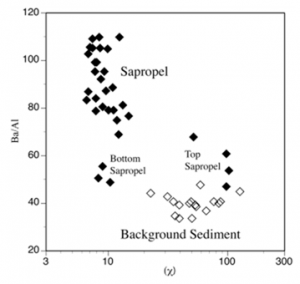
Magnetic susceptibility (mass specific χ; 10-6 m3 kg-1) vs Ba/Al ratio for samples from Core ET99-M11 (from Vigliotti et al. (2011)). Samples at the bottom of the sapropel indicate that significant magnetic dissolution took place. A moderate increase in the Ba/Al ratio suggests higher sensitivity of the magnetic parameters to the environmental changes occurring during sapropel deposition.
It’s not only geochemical measurements that can help identify ghost sapropels, those that are present even when the lithological signatures are missing. Magnetic parameters can be used to indicate paleoredox conditions (low oxygen levels) in the water column. The process of magnetic minerals accumulating in the sedimentary column is known as the acquisition of a depositional remanent magnetisation (see this page from the Institute of Rock Magnetism, Minnesota, about the different types of remanence held in rocks). Rock magnetic parameters show a very distinct signature with respect to sapropels as shown by Dekkers et al. (1994) and Langereis et al. (1997). Just above a sapropel it is not uncommon to find that magnetic minerals precipitate, whilst just below it, magnetic minerals tend to dissolve. This can be tested for by measuring low values of anhysteretic remanent magnetization[SJM1] (ARM, which is imparted in the laboratory by slowly reducing a peak alternating field to zero while at the same time applying a constant DC). The above being true, you would expect very low values of ARM at the base of sapropels, as shown by Dekkers et al., (1994). The measurement of magnetic susceptibility can also be used as an indicator for the presence of ‘ghost sapropels’. Susceptibility plotted against ratios of Br/Al concentrations are indicative of the top and base of sapropels as show in this diagram by Vigliotti et al. (2011).
The use of magnetic measurements in understanding sapropels and reconstructing past environments is not restricted to the study of the rock magnetic minerals in the sediment; magnetostratigraphy can be used to establish the age of the cores and the total time span sampled by the recovered sediments where dating of sediment cores via traditional means is problematic. I hope to cover some of those aspects in a bit more detail in our next post.
We hope you’ve enjoyed our first post; we will take a more detailed look at proposed mechanisms for sapropel formation in a follow-up post (now uploaded here!) to appear on the blog shortly. Stay tuned for more posts on: palaeoenvironmental reconstructions and how geophysics and geomagnetism in particular can contribute to our understanding of those; cutting edge research in the fields of Achaean geology, geophysics, geomagnetism from Laura! Dan will report on research being conducted by Quaternary scientists working in glacial, marine, fluvial or lacustrine settings to better understand past environmental changes.
It is worth noting that all ODP Proceedings are in the public domain and not copyrighted; if you would like more information, it is worth browsing the ODP website for their Mediterranean Reports (e.g., Volume 160). In the meantime, here are the references we’ve incorporated:
Dekkers, M.J. et al. (1994) Fuzzy c-means cluster analysis of early diagenetic effects on natural remanent magentisation in a 1.1 Myr piston core from the Central Mediterranean. Phys.Earth planet.Inter., v.85, p.155-171.
DOI: http://dx.doi.org/10.1016/0031-9201(94)90014-0
Emais, K.C. et al. (2003) Eastern Mediterranean surface water temperatures and δ18O composition during deposition of sapropels in the late Quaternary. Palaeoceanography, v. 18(1), 1005
DOI: http://dx.doi.org/10.1029/2000PA000617
Langerair, C.G. et al (1997) Magnetostratigraphy and astronomical calibration of the last 1.1Myr from an eastern Mediterranean piston core and dating short events in the Brunhes.
Geophysical Journal International, v. 129, p. 75-94.
DOI: http://dx.doi.org/10.1111/j.1365-246X.1997.tb00938.x
Moller, T. et al., (2012) Sedimentology and geochemistry of an exceptionally preserved last interglacial sapropel S5 in the Levantine Basin (Mediterranean Sea). Marine Geology, v.291-294, p.24-38
DOI: http://dx.doi.org/10.1016/j.margeo.2011.10.011
Rossingol-Strick, M. et al. (1982) After the deluge: Mediterranean stagnation and sapropel formation. Nature, v. 295, p. 105-110
DOI: http://dx.doi.org/10.1038/295105a0
Vigliotti, L.A. et al. (2011). Magnetic properties of the youngest sapropel S1 in the Ionian and Adriatic Sea: inference for the timing and mechanism of sapropel formation. Italian Journal of Geosciences, v.130, p. 106-118
DOI: http://dx.doi.org/10.3301/IJG.2010.29

